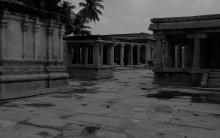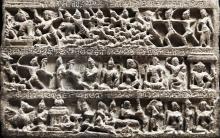Bhallaṭa
Bhallaṭa is best remembered as the poet who put the genre of anyokti (allegorical verses) on the map. He composed a century of verses and elevated this genre, which was only a trickle before. To this day, his poem arguably remains the best of its kind. A verse from the opening section of Bhallaṭaśataka describes the nature of suggestive poetry in a memorable manner:
बद्धा यदर्पणरसेन विमर्दपूर्व-









